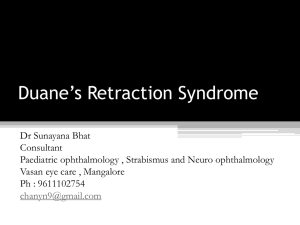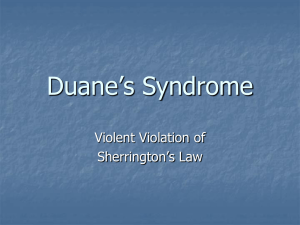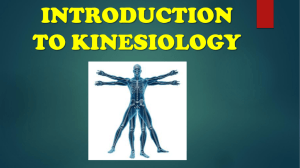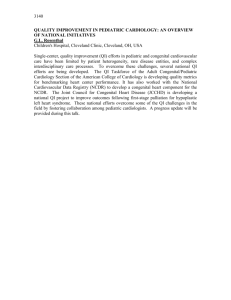الشريحة 1
advertisement
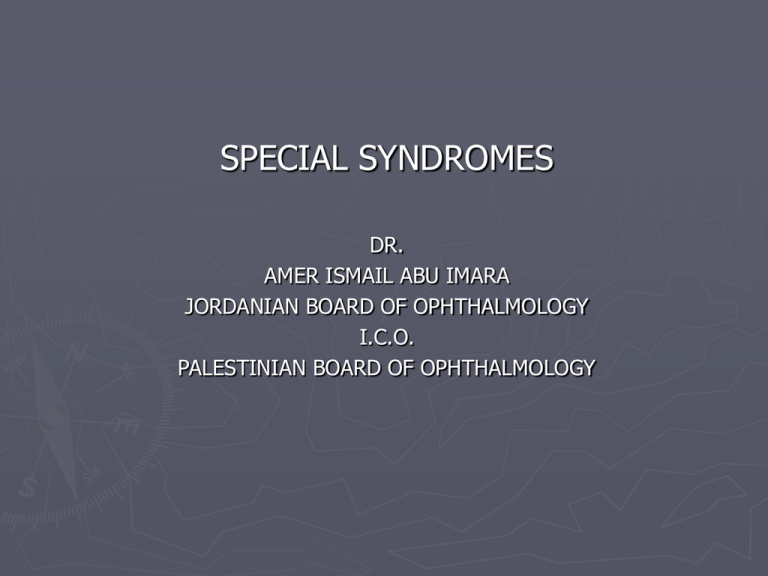
SPECIAL SYNDROMES DR. AMER ISMAIL ABU IMARA JORDANIAN BOARD OF OPHTHALMOLOGY I.C.O. PALESTINIAN BOARD OF OPHTHALMOLOGY Recent genetic and neuropathological studies have shown that a group of congenital neuromuscular disorders are the result of developmental errors in innervation of ocular and facial muscles . These conditions are now referred to as congenital cranial dysinnervation disorders and include Duane syndrome , Mobius syndrome , congenital fibrosis of extraocular muscles , Marcus Gunn jaw-winking syndrome , congenital ptosis and congenital facial palsy . DUANE RETRACTION SYNDROME In Duane retraction syndrome there is failure of innervation of the lateral rectus by the sixth nerve , with anomalous innervation of the lateral rectus by fibers from the third nerve . The condition is often bilateral , although frequently involvement in one eye may be very subtle . Some children have associated congenital defects such as perceptive deafness and speech disorder. DIAGNOSIS There is usually BSV in the primary position , often with a face turn . The affected eye shows the following motility defects : 1- restricted abduction , which may be complete or partial . 2- restricted adduction which is usually partial and rarely complete . 3- retraction of the globe on adduction as a result of co-contraction of the medial and lateral recti with resultant narrowing of the palpebral fissure . The degree of globe retraction may vary from gross to almost imperceptible . On attempted abduction , the palpebral fissure opens and the globe assumes its normal position . 4- An up-shoot or down-shoot in adduction may be present . It has been suggested that this is a ( bridle ) or ( leash ) phenomenon , produced by a tight lateral rectus lateral rectus muscle which slips over or under the globe and produces an anomalous vertical movement of the eye . However recent studies with MRI have shown that this is not always the case . 5- deficiency of convergence in which the affected eye remains fixed in the primary position while the unaffected eye is converging . KLASSIFICATION ( Huber ) Type 1 , the most common , is characterized by : - Limited or absent abduction . - Normal or mildly limited adduction . - In the primary position , straight or slight esotropia . Type 2 , the least common , is characterized by : - Limited adduction - Normal or mildly limited abduction - In primary position , straight or slight exotropia . Type 3 is characterized by : - Limited adduction and abduction . - In the primary position , straight or slight esotropia . NB The underlying pathophysiology is similar in all three types , the differences being due to inequality in the degree of anomaly in the innervation to the lateral and medial recti . MANAGEMENT Most young children maintain BSV by using an abnormal head posture to compensate for their lateral rectus weakness and surgery is only needed if there is evidence of loss of binocular function , which may be indicated by failure to continue to use an abnormal head posture . In adults or children over the age of about 8 years surgery can reduce a cosmetically unacceptable head posture or one causing neck discomfort . Surgery may also be necessary for cosmetically unacceptable up-shoots , down-shoots or severe globe retraction . Amblyopia , when present , is usually the result of anisometropia rather than strabismus . Unilateral or bilateral muscle recession or transposition of the vertical recti are the procedures of choice . NB the lateral rectus of the involved side should not be resected , as this increases retraction . عرض فيديو BROWN SYNDROME Brown syndrome is a mechanical condition which is usually congenital but occasionally may be acquired . Classification 1- congenital - Idiopathic - Congenital click syndrome where there is impaired movement of the superior oblique tendon through the trochlea . 2- acquired - Trauma to the trochlea or superior oblique tendon - Inflammation of the tendon which may be caused by rheumatoid arthritis , pansinusitis and scleritis . Diagnosis A right Brown syndrome has the following characteristics : - 1- major signs - Usually straight with BSV in the primary position - Limited right elevation in adduction and occasionally also in the midline - Normal right elevation in abduction Absence of right superior oblique overaction Positive forced duction test on elevating the globe in adduction . - 2- variable signs - down-shoot in adduction - Hypotropia in primary position AHP with chin elevation and ipsilateral head tilt . Treatment 1- congenital cases do not usually require treatment as long as binocular function is maintained with an acceptable head posture. Spontaneous improvement is often seen towards the end of the first decade . Indications for treatment include significant primary position hypotropia , deteriorating control and/or an unacceptable head posture . The recommended procedure for congenital cases is lengthening of the superior oblique tendon . 2- acquired cases may benefit from steroids , either orally or by injection near the trochlea , together with treatment of any underlying cause . عرض فيديو MONOCULAR ELEVATION DEFICIT Monocular elevator palsy , sometimes also referred to as double elevator palsy , is a rare sporadic condition . It is thought to be caused by either a tight or contracted inferior rectus muscle or a hypoplastic or ineffective superior rectus muscle . 1- signs - Profound inability to elevate one eye . - The abnormality of up-gaze persists across the horizontal plane , from abduction to adduction . Orthophoria in the primary position in about one-third of cases . - Chin elevation to obtain fusion in down gaze may be present . 2- treatment involving base-up prism over the involved eye or surgery should be considered when fusion in the primary position has been compromised or a chin elevation is required to maintain fusion . عرض فيديو - MOBIUS SYNDROME Mobius syndrome is a very rare congenital , sporadic condition . 1- ocular features - Horizontal gaze palsy is present in 50% of cases . - Bilateral sixth nerve palsy . - 2- systemic features Bilateral facial palsy , usually asymmetrical and often incomplete , giving rise to a mask-like facial expression and problems with lid closure . - Paresis of the ninth and twelfth cranial nerves , the later results in atrophy of the tongue . - Mild mental handicap. - Limb anomalies . عرض فيديو - CONGENITAL FIBROSIS OF EXTRAOCULAR MUSCLES It is a rare non-progressive usually AD disorder characterized by bilateral ptosis and restrictive external ophthalmoplegia . - In the primary position each eye is fixed below the horizontal by 10° . - The hypotropic eye may be secondarily exotropic, esotropic or neutral . The degree of residual horizontal movement varies from full to absent . Vertical movements are always severely restricted with inability to elevate the eyes above the horizontal plane . Absence of binocular vision and amblyopia may be present in some cases . - - STRABISMUS FIXUS It is a very rare condition , in which both eyes are fixed by fibrous tightening of the medial recti ( convergent strabismus fixus ) or the lateral recti ( divergent strabismus fixus ) .

